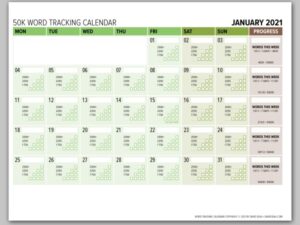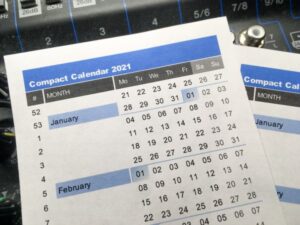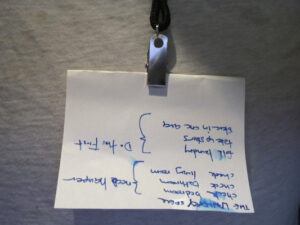(last edited on December 22, 2022 at 3:53 pm)
 It’s been about a month since I made my Concrete Goals Tracking worksheet, aka The Printable CEO. In that month, about 8000 people have visited the original page, and about 1700 have actually downloaded it. Another 500 enterprising folks have downloaded the editable Excel version. Cool!
It’s been about a month since I made my Concrete Goals Tracking worksheet, aka The Printable CEO. In that month, about 8000 people have visited the original page, and about 1700 have actually downloaded it. Another 500 enterprising folks have downloaded the editable Excel version. Cool!
But does it work? I’ve been using it for the past four weeks; here’s my report.
What was The Printable CEO Again?
 In case you missed it before, The Printable CEO is just a tracking form I made to keep my focused on growing my freelance business. It’s a paper-based, using a carefully chosen list of of tasks coupled with a motivational point-based tracking grid. My past interest in game design and development–and acknowledgement of my slacker-perfectionist tendencies–led me to structure it as reward bonus system as opposed to a completion tracking system. In other words: it’s good feedback when it has relevance in the game system; in my case, that’s “making money”, “maintaining connections that lead to opportunities” and “making assets that will make money later”. Whenever I do something on the list, I know it’s one of these things, and that those things contribute directly to the growth of my practice.
In case you missed it before, The Printable CEO is just a tracking form I made to keep my focused on growing my freelance business. It’s a paper-based, using a carefully chosen list of of tasks coupled with a motivational point-based tracking grid. My past interest in game design and development–and acknowledgement of my slacker-perfectionist tendencies–led me to structure it as reward bonus system as opposed to a completion tracking system. In other words: it’s good feedback when it has relevance in the game system; in my case, that’s “making money”, “maintaining connections that lead to opportunities” and “making assets that will make money later”. Whenever I do something on the list, I know it’s one of these things, and that those things contribute directly to the growth of my practice.
 I think To Do lists are fine tools for managing tasks, but they’re somewhat cumbersome when it comes to motivating personal or business development. If anything, they are demotivators, because things that aren’t on the To Do List still have to get done. I am a company of one, and I have to deal with unexpected client interruptions, computer issues, fleeting business opportunities and other small fires every day. The Printable CEO is my reminder that yes, I must develop assets that pay off in the form of new creative business opportunities. And money–crass as that sounds, I need to make sure I’m making enough money so I maintain creative independence.
I think To Do lists are fine tools for managing tasks, but they’re somewhat cumbersome when it comes to motivating personal or business development. If anything, they are demotivators, because things that aren’t on the To Do List still have to get done. I am a company of one, and I have to deal with unexpected client interruptions, computer issues, fleeting business opportunities and other small fires every day. The Printable CEO is my reminder that yes, I must develop assets that pay off in the form of new creative business opportunities. And money–crass as that sounds, I need to make sure I’m making enough money so I maintain creative independence.
So How Has It Been?
I’ve been, as they say, eating my own dogfood by using the Printable CEO for the past four weeks. My personal experience has been pretty positive; observations follow:
- Filling in the bubbles is still strangely satisfying, even after four weeks. The experience isn’t as spiritual as it used to be, but I just like using the No. 2 pencil to fill in that bubble. There’s a fun doodling feel to it; perhaps it triggers a similar reflective frame of mind, activating the right side of the brain?
I found the Notes Area quickly became a kind of pseudo-todo list, because the form was generally handy. Put important information where your eyeballs can find it easily! I tended to list things that I wanted to do for the day, and then add the points with a “+5” or “+2” modifier as they got done. I also wrote some phone numbers on it. Developing this into a full task tracking system on the side is a new project I’m undertaking to extend the concepts.
If I didn’t write down the tasks I did right away, I would forget them. So it was very important that I wrote down tasks as they happened.
The weighted list of goals was absolutely critical in making this work. I found that there were days that I looked over the list to find something to do that would bump up my point count for the week. I also found myself looking at every task to see whether or not it was worth points. The beauty of this is that this is exactly the mentality I want to inculcate: thinking about business development activity all the time! Ordinarily, one might think of “spinning” every activities to be worth points as being a form of cheating, but in this case it’s not. It’s resourcefulness and adaptability instead. Choosing the right goals, of course, is the tricky part. Your goals should all have concrete results; if the fruits of your labor can not be counted like money or shown to someone else, then your goals are not concrete.
Counting weekly points at the end of the week gave me a feel for what a “productive” week should be. A good week runs about 50 points, which includes talking with people and posting a few blog articles. That works out to about 7 points a day (including weekends). Add billable work to the mix, then the points double. I add +10 points for each project performed as billable work, so if I do two projects in a day, that’s a +20. However, if the billable work was under an hour, I would score it as a +5. My best week was 107 points, which included about 3 days of billable work.
The original ten goals covered every situation except for one: measuring qualitative return on investment. Following the original list, I got points only when I made something, counted something, or did billable work. However, I realized I should also record when an asset pays off again without requiring further work on my part. I had forgotten to account for this in the system; proof of an asset bringing in revenue is cause for celebration, because it means it’s out there working for me. For example, say that someone wants to hire me because they read an article on my blog. Although I had already earned +2 points for the article writing, I give myself another +2 points because someone actually noticed it. Likewise, if someone wants to hire me because of some artwork I did, I would give myself another +5 points. Every time that artwork works for me, it should give me another 5 points. This reinforces the importance of creating good assets; they are worth way more points in the long run, and I believe this is important to the long-term viability of my business.
Now what to do with these points. They’re useful for getting a quick qualitative measure of how busy one is, but I also have the desire to redeem them somehow. Like, for every 1000 points, I get to do something fun or buy something cool. This could work well in a school setting. Choosing the reward, of course, should follow the principle of good asset purchasing; if you buy something, make sure it can help you make MORE assets. I think that’s called a “capital investment”.
<
p>##Summing Up So is it working? Yeah, it is.
I know I’m making progress because I can see the numbers every day. The overhead of tracking these tasks is very low because it’s bubble-based, and the concrete goals list makes it easy to focus on something productive to do. What’s really cool is that these forms help maintain continuity in my daily goal-directed actions; that’s another prerequisite for good feedback in a game system.
For the past two weeks, I’ve been more busy with billable work, and have found I’ve had to go back and make some To Do lists after all; like I said, they’re great for managing tasks. I found myself starting to use the Printable CEO Notes area for keeping a small To Do list since I was always looking at it. I will probably incorporate this into Version 2.0 of the Printable CEO in the weeks to come.
I was also talking to some friends over lunch, and it occured to me that The Printable CEO has a strange appeal to procrastinators. One of my friends is the Anti-Procrastinator. She just gets things done, and a To Do list is a great tool for her. Another friend is a procrastinator-perfectionist; he doesn’t start those big personal projects because he doesn’t have the time to do them right. I can identify with that myself; I have no trouble planning out a project in terms of hours, resources, and manpower, but I just would rather not do it for something I love to do. I want it to flow more naturally. As I type that out it seems a little silly, but that’s the way things are for me. The Printable CEO is not a To Do list. It’s an I DID list, rewarding productive behavior when it happens to happen. That’s an important distinction to note. And because it only rewards the correct actions, it is also a kind of conditioning tool.
So that’s how it’s going for me. How’s it going for you? You might find The Making Of The Printable CEO useful if you’re adapting it to your own purposes.
Update: Task Tracking
 Now that you have your task direction established, check out Part II of The Printable CEO for Task Progress Tracking!
Now that you have your task direction established, check out Part II of The Printable CEO for Task Progress Tracking!






6 Comments
I came across a great description of why the bubbles work over on But she’s a girl… Noted here for future reference!
David,
This is very cool – I’ll be trying it out.
It would be even cooler to have a pocketmod version – I know you have the minibooklet, but that means we sacrifice all the other pocketmod goodness..
What would be interesting (to me at least) – is if you could post up a graph of your scores over time. Do you find your scores tend to increase? Stay constant? Good days and bad days?
Thanks for the great ideas!
– Darren
I agree with the statement that goals must be concrete. I read something yesterday that also recommended that goals should be binary. It should be possible to answer, “have I completed this goal?” with yes or no.
Darren: I’ll post a graph of the scores over time. They tend to vary. Since my goals are oriented toward business development, they tend to be high points when I’m not working (and therefore hustlin’) and low when I actually DO have work. This week I’ve been on semi-vacation, mostly doing research which doesn’t score any points at all, so it’s going to be a low week.
There are probably two other areas I need to track: actual project work (different system entirely) and R&D. I don’t want to overburden the simplicity of the system.
Jerry: That’s a good point, about binary-ness of goals being important. It’s hard though, if the goal isn’t a small step. So, for me part of concreteness is that the goal is small enough to judged “complete’ without a lot of qualification, and that it’s still big enough to be a measurable step in the right direction. Goals is such an ambiguous term that I’m considering taking it out of the CGT worksheet.
I’m in my second week of this and it’s going well. Anything that makes life more like a video game is good for me.
I’m having a little trouble categorizing some of the work I do that isn’t billable but may lead to income. A couple examples from animation work:
a) Preparing for a pitch meeting including making mock boards, pitch documents, etc. I’ve given tat two points as business development. But am considering making it 5 points because it does have the potential to pay off and is worth doing.
b) Preparing animation on spec (usually for personal projects, never for anyone that isn’t a close friend). This one is trickier. There’s no obvious income in this for a significant period of time. I’m sort of putting this one in the 2pt category for now.
Overall I love the challenge of finding good game balance between: Do I need motivation? and Does it generate revenue?
It’s a great balance to play with.
g
Hey Gahlord,
Glad it’s going well! I generally award myself points when the task I’m doing is tangible; that is, it’s something that I can see with my eyes, that can be shown to someone else. The theory is that people respond better when they can see work that you’ve done, or something that you’ve made. And of course, you can give yourself more points if something just FEELS like it’s worth more, and if you do something particularly cool, you could award it multiple times.
For me, if I did an Animation on Spec: If it’s something you can put in your portfolio and show someone else, then that could be worth more points. But only if I show it to someone. So the act of finishing it might be worth 5 points, and then showing it to someone might be worth 2 points. If you finish something and sit on it, then it’s sort of a gray area…up to you. Depends on what needs doing more…just making, or showing.
Glad you’re having a good time with it!